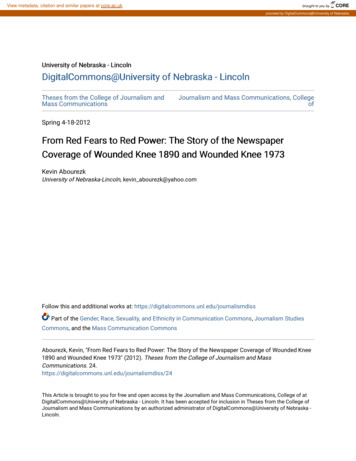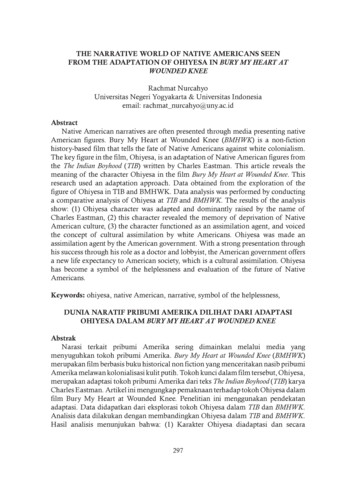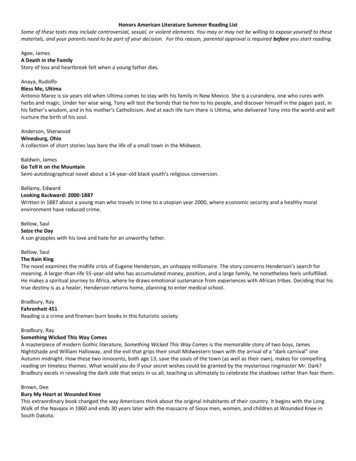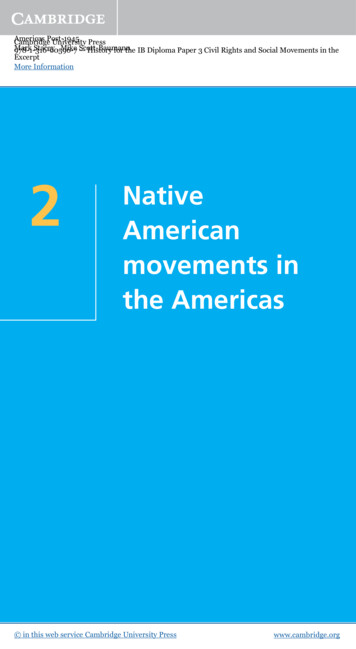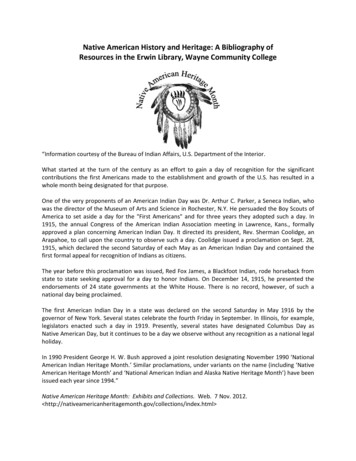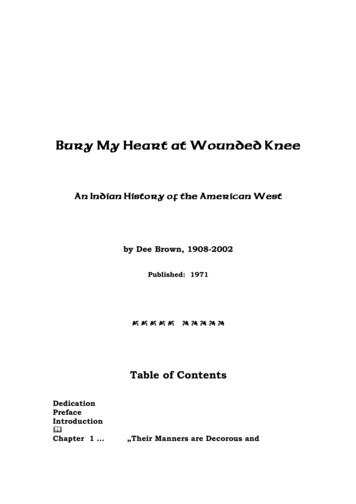
Transcription
Bury My Heart at Wounded KneeAn Indian History of the American Westby Dee Brown, 1908-2002Published: 1971JJJJJIIIIITable of ContentsDedicationPrefaceIntroductionChapter 1 „Their Manners are Decorous and
apterChapterChapterChapterPraiseworthy”The Long Walk of the NavahosLittle Crow’s WarWar Comes to the CheyennesPowder River InvasionRed Cloud’s War„The Only Good Indian Is a Dead Indian”The Rise and Fall of Donehogawa.Cochise and the Apache Guerrillas.The Ordeal of Captain Jack.The War to Save the Buffalo.The War for the Black Hills.The Flight of the Nez Percés.Cheyenne Exodus.Standing Bear Becomes a Person.„The Utes Must Go!”The Last of the Apache Chiefs.Dance of the Ghosts.Wounded Knee.2 3 4 5 6 7 8 9 10 11 12 13 14 15 16 17 18 19 o, chief of the Navahos[painted by Julian Scott for the United States Census Bureau in 1891]Juanita, wife of Manuelito, as a member of the Navaho delegation toWashington in 1874[Photo from the Smithsonian Institution]A Navaho warrior of the 1860’s[Photographed by John Gaw Meem and reproduced by permission ofthe Denver Art Museum]Little Crow, or Tshe-ton Wa-ka-wa Ma-ni, the Hawk That HuntsWalking[From a photograph taken in 1858 by A. Zeno Shindler, courtesy of theSmithsonian Institution]Big Eagle[Photo by Simons and Shepherd at Camp McClellan in Davenport,Iowa. Courtesy of Minnesota Historical Society]Cheyenne and Arapaho chiefs meeting at the Camp Weld Council onSeptember 28, 1864.Little Raven, chief of the Arapahos.[Photographer not recorded, but taken prior to 1877. Courtesy of the
44567789910111111111111Smithsonian Institution]George Bent and his wife, Magpie[Photographed in 1867. Courtesy of State Historical Society ofColorado]Edmond Guerrier, interpreter[Photographer not recorded, but taken prior to 1877. Courtesy of theSmithsonian Institution]Red Cloud, or Mahpiua-luta, of the Oglala Dakotas[Photographed by Charles M. Bell in Washington, D.C., in 1880.Courtesy of the Smithsonian Institution]Spotted Tail, or Sinte-Galeshka, of the Brulé Sioux.[From a painting by Henry Ulke made in 1877, now in the NationalPortrait Gallery of the Smithsonian Institution.]Roman Nose, of the Southern Cheyennes.[Either photographed or copied by A. Zeno Shindler in Washington,D.C., 1868. Courtesy of the Smithsonian Institution.]Tosawi, or Silver Knife, chief of the Comanches.[Photographed by Alexander Gardner in Washington, D.C., 1872.Courtesy of the Smithsonian Institution]Ely Parker, or Donehogawa, Seneca chief, military secretary to U.S.Grant and Commissioner of Indian Affairs[Photographed around 1867. Courtesy of the Smithsonian Institution]Cochise[Reproduced from a painting in the Arizona Historical Society]Eskiminzin, head chief of the Aravaipa Apaches[Photographed probably by Charles M. Bell in Washington, D.C., 1876.Courtesy of the Smithsonian Institution]Captain Jack, or Kintpuash, Having the Water Brash[Photographed by L. Heller in 1873. Courtesy of the SmithsonianInstitution]Satanta, or White Bear[From a photograph by William S. Soule, taken around 1870. Courtesyof the Smithsonian Institution]Lone Wolf, or Guipago[Photographed by William S. Soule sometime between 1867 and 1874.Courtesy of the Smithsonian Institution]Kicking Bird, chief of the Kiowas[Photographed by William S. Soule at Fort Dodge, Kansas, in 1868.Courtesy of the Smithsonian Institution]Ten Bears of the Comanches[Photographed by Alexander Gardner in Washington, D.C., 1872.Courtesy of the Smithsonian Institution]White Horse, or Tsen-tainte[Photographed by William S. Soule in 1870. Courtesy of theSmithsonian Institution]Quanah Parker of the Comanches[Photographed by Hutchins and/or Lanney on the Kiowa reservation
1212121212121212131414151616161617171717(for Kiowas, Comanches, and Kiowa-Apaches) in Oklahoma between1891 and 1893. Courtesy of the Smithsonian Institution]Sitting Bull[Photo from the U.S. Signal Corps]Gall[Photo from the U.S. Signal Corps]Two Moon, chief of the Cheyennes[Courtesy of Denver Public Library]Hump[Photographed at Fort Bennett, South Dakota, in 1890. Photo from theNational Archives]Crow King of the Sioux[Courtesy of Denver Public Library]Young-Man-Afraid-of-His-Horses[Courtesy of the Nebraska State Historical Society]Little Big Man[Photo from the U.S. Signal Corps]No photograph of Crazy Horse has ever been authenticated, but AmosBad Heart Bull made this pictograph of his murder at Fort Robinson[From The Pictographic History of the Oglala Sioux, University ofNebraska Press, used by special permission]Chief Joseph of the Nez Percés[Photo from the National Archives]Dull Knife[Courtesy of the Smithsonian Institution]Little Wolf[Courtesy of the Smithsonian Institution]Chief Standing Bear of the Poncas[Courtesy of Nebraska State Historical Society]Ouray[Courtesy of State Historical Society of Colorado]Nicaagat (Jack)[From a group photograph taken around 1874. Courtesy of StateHistorical Society of Colorado]Quinkent, or Douglas[Courtesy of State Historical Society of Colorado]Colorow[Possibly a William H. Jackson photograph. Courtesy ofState Historical Society of Colorado]Geronimo[From a photograph taken by A. Frank Randall in 1886. Courtesy ofthe Smithsonian Institution]Naiche and his wife[Courtesy of Arizona Historical Society]Victorio[Courtesy of Arizona Historical Society]Nana
181818181919[Courtesy of Arizona Historical Society]Wovoka, the Paiute Messiah[Courtesy of the Smithsonian Institution]Kicking Bear[Photo by David F. Barry, from the Denver Public Library WesternCollection]Short Bull of the Sioux[Photo by David F. Barry, from the Denver Public Library]John Grass[Photo by David F. Barry, from the Denver Public LibraryWestern Collection]Big Foot in death[Photographed at the Wounded Knee battlefield. Courtesy of theSmithsonian Institution]Red Cloud in old age[Reproduced from the collections of the Library of Congress.Photograph by E. S. Curtis]JJJJJIIIIIFor Nicolas Brave WolfPrefaceAN ANCIENT TRADITION TELLS us that the interval between the birth of theparents and the arrival of their first offspring averages thirty years. We call that ageneration. Thirty years ago, early in 1971, this book was born. And so now it isbeginning its second generation.As the first generation ends, it is almost a cliché to say that enormous changeshave occurred during the time that has passed. Yet vast changes certainly haveaffected the present-day descendants of the old tribal prophets whose stories aretold in these pages.During the past generation, some tribal reservations have prospered, othershave not. There are now, and probably always will be, disagreements within tribesas to the direction their people should take. In spite of the many personalfrustrations and difficulties young seekers of knowledge experience, it is no longerunusual to meet American-Indian lawyers, physicians, college professors,computer specialists, artists, writers, or members of almost any other professionor trade. Yet on some reservations there is still a shortage of proper places in
which to live. And the county with the deepest poverty in the United States is stilla tribal reservation.Judging from letters I have received through the years, the readers who havegiven life to this book come from almost all the hundred or so ethnic groups thatcomprise this unique and awesome place called America. Small though thecomparative number of American Indians is, almost all other Americans seem tohave an earnest fascination for their history, their arts and literature, theirattitude toward the natural world, and their philosophy of human existence.And this wide interest exists beyond the borders of America into the lands ofother people and other cultures. Name a small nation, one whose people have ahistory of past injustices and oppression, and this book will likely be in printthere.We rarely know the full power of words, in print or spoken. It is my hope thattime has not dulled the words herein and that they will continue through thecoming generation to be as true and direct as I originally meant them to be.DEE BROWNin the year 2000IntroductionSINCE THE EXPLORATORY JOURNEY of Lewis and Clark to the Pacific Coastearly in the nineteenth century, the number of published accounts describing the“opening” of the American West has risen into the thousands. The greatestconcentration of recorded experience and observation came out of the thirty-yearspan between 1860 and 1890—the period covered by this book. It was anincredible era of violence, greed, audacity, sentimentality, undirected exuberance,and an almost reverential attitude toward the ideal of personal freedom for thosewho already had it.During that time the culture and civilization of the American Indian wasdestroyed, and out of that time came virtually all the great myths of the AmericanWest—tales of fur traders, mountain men, steamboat pilots, goldseekers,gamblers, gunmen, cavalrymen, cowboys, harlots, missionaries, schoolmarms,and homesteaders. Only occasionally was the voice of an Indian heard, and thenmore often than not it was recorded by the pen of a white man. The Indian was thedark menace of the myths, and even if he had known how to write in English,where would he have found a printer or a publisher?Yet they are not all lost, those Indian voices of the past. A few authenticaccounts of American western history were recorded by Indians either inpictographs or in translated English, and some managed to get published inobscure journals, pamphlets, or books of small circulation. In the late nineteenthcentury, when the white man’s curiosity about Indian survivors of the warsreached a high point, enterprising newspaper reporters frequently interviewedwarriors and chiefs and gave them an opportunity to express their opinions onwhat was happening in the West. The quality of these interviews varied greatly,
depending upon the abilities of the interpreters, or upon the inclination of theIndians to speak freely. Some feared reprisals for telling the truth, while othersdelighted in hoaxing reporters with tall tales and shaggy-dog stories.Contemporary newspaper statements by Indians must therefore be read withskepticism, although some of them are masterpieces of irony and others burn withoutbursts of poetic fury.Among the richest sources of first-person statements by Indians are the recordsof treaty councils and other formal meetings with civilian and militaryrepresentatives of the United States government. Isaac Pitman’s new stenographicsystem was coming into vogue during the second half of the nineteenth century,and when Indians spoke in council a recording clerk sat beside the officialinterpreter.Even when the meetings were in remote parts of the West, someone usually wasavailable to write down the speeches, and because of the slowness of thetranslation process, much of what was said could be recorded in longhand.Interpreters quite often were half-bloods who knew spoken languages but seldomcould read or write. Like most oral peoples they and the Indians depended uponimagery to express their thoughts, so that the English translations were filled withgraphic similes and metaphors of the natural world. If an eloquent Indian had apoor interpreter, his words might be transformed to flat prose, but a goodinterpreter could make a poor speaker sound poetic.Most Indian leaders spoke freely and candidly in councils with white officials,and as they became more sophisticated in such matters during the 1870’s and1880’s, they demanded the right to choose their own interpreters and recorders. Inthis latter period, all members of the tribes were free to speak, and some of theolder men chose such opportunities to recount events they had witnessed in thepast, or to sum up the histories of their peoples. Although the Indians who livedthrough this doom period of their civilization have vanished from the earth,millions of their words are preserved in official records. Many of the moreimportant council proceedings were published in government documents andreports.Out of all these sources of almost forgotten oral history, I have tried to fashion anarrative of the conquest of the American West as the victims experienced it, usingtheir own words whenever possible. Americans who have always looked westwardwhen reading about this period should read this book facing eastward.This is not a cheerful book, but history has a way of intruding upon the present,and perhaps those who read it will have a clearer understanding of what theAmerican Indian is, by knowing what he was. They may be surprised to hearwords of gentle reasonableness coming from the mouths of Indians stereotyped inthe American myth as ruthless savages. They may learn something about theirown relationship to the earth from a people who were true conservationists. TheIndians knew that life was equated with the earth and its resources, that Americawas a paradise, and they could not comprehend why the intruders from the Eastwere determined to destroy all that was Indian as well as America itself.And if the readers of this book should ever chance to see the poverty, thehopelessness, and the squalor of a modern Indian reservation, they may find itpossible to truly understand the reasons why.
Urbana, IllinoisApril, 1970Dee BrownI shall not be there. I shall rise and pass. Bury my heart at Wounded Knee.—STEPHEN VINCENT BENETChapter 1„Their Manners are Decorous and Praiseworthy”Where today are the Pequot? Where are the Narragansett, the Mohican, thePokanoket, and many other once powerful tribes of our people? They havevanished before the avarice and the oppression of the White Man, as snowbefore a summer sun.Will we let ourselves be destroyed in our turn without a struggle, give up ourhomes, our country bequeathed to us by the Great Spirit, the graves of our deadand everything that is dear and sacred to us? I know you will cry with me,“Never! Never!”—TECUMSEH OF THE SHAWNEESIT BEGAN WITH CHRISTOPHER Columbus, who gave the people the nameIndios. Those Europeans, the white men, spoke in different dialects, and somepronounced the word Indien, or Indianer, or Indian. Peaux-rouges, or redskins,came later. As was the custom of the people when receiving strangers, the Tainoson the island of San Salvador generously presented Columbus and his men withgifts and treated them with honor.“So tractable, so peaceable, are these people,” Columbus wrote to the King andQueen of Spain, “that I swear to your Majesties there is not in the world a betternation. They love their neighbors as themselves, and their discourse is ever sweetand gentle, and accompanied with a smile; and though it is true that they arenaked, yet their manners are decorous and praiseworthy.”All this, of course, was taken as a sign of weakness, if not heathenism, andColumbus being a righteous European was convinced the people should be “madeto work, sow and do all that is necessary and to adopt our ways.” Over the nextfour centuries (1492–1890) several million Europeans and their descendantsundertook to enforce their ways upon the people of the New World.Columbus kidnapped ten of his friendly Taino hosts and carried them off toSpain, where they could be introduced to the white man’s ways. One of them diedsoon after arriving there, but not before he was baptized a Christian. TheSpaniards were so pleased that they had made it possible for the first Indian to
enter heaven that they hastened to spread the good news throughout the WestIndies.The Tainos and other Arawak people did not resist conversion to the Europeans’religion, but they did resist strongly when hordes of these bearded strangers beganscouring their islands in search of gold and precious stones. The Spaniards lootedand burned villages; they kidnapped hundreds of men, women, and children andshipped them to Europe to be sold as slaves. Arawak resistance brought on theuse of guns and sabers, and whole tribes were destroyed, hundreds of thousandsof people in less than a decade after Columbus set foot on the beach of SanSalvador, October 12, 1492.Communications between the tribes of the New World were slow, and news ofthe Europeans’ barbarities rarely overtook the rapid spread of new conquests andsettlements. Long before the English-speaking white men arrived in Virginia in1607, however, the Powhatans had heard rumors about the civilizing techniquesof the Spaniards. The Englishmen used subtler methods. To ensure peace longenough to establish a settlement at Jamestown, they put a golden crown upon thehead of Wahunsonacook, dubbed him King Powhatan, and convinced him that heshould put his people to work supplying the white settlers with food.Wahunsonacook vacillated between loyalty to his rebellious subjects and to theEnglish, but after John Rolfe married his daughter, Pocahontas, he apparentlydecided that he was more English than Indian. After Wahunsonacook died, thePowhatans rose up in revenge to drive the Englishmen back into the sea fromwhich they had come, but the Indians underestimated the power of Englishweapons. In a short time the eight thousand Powhatans were reduced to less thana thousand.In Massachusetts the story began somewhat differently but ended virtually thesame as in Virginia. After the Englishmen landed at Plymouth in 1620, most ofthem probably would have starved to death but for aid received from friendlynatives of the New World. A Pemaquid named Samoset and three Wampanoagsnamed Massasoit, Squanto, and Hobomah became self-appointed missionaries tothe Pilgrims. All spoke some English, learned from explorers who had touchedashore in previous years. Squanto had been kidnapped by an English seaman whosold him into slavery in Spain, but he escaped through the aid of anotherEnglishman and finally managed to return home. He and the other Indiansregarded the Plymouth colonists as helpless children; they shared corn with themfrom the tribal stores, showed them where and how to catch fish, and got themthrough the first winter. When spring came they gave the white men some seedcorn and showed them how to plant and cultivate it.For several years these Englishmen and their Indian neighbors lived in peace,but many more shiploads of white people continued coming ashore. The ring ofaxes and the crash of falling trees echoed up and down the coasts of the landwhich the white men now called New England. Settlements began crowding inupon each other. In 1625 some of the colonists asked Samoset to give them12,000 additional acres of Pemaquid land. Samoset knew that land came from theGreat Spirit, was as endless as the sky, and belonged to no man. To humor thesestrangers in their strange ways, however, he went through a ceremony of
transferring the land and made his mark on a paper for them. It was the first deedof Indian land to English colonists.Most of the other settlers, coming in by thousands now, did not bother to gothrough such a ceremony. By the time Massasoit, great chief of the Wampanoags,died in 1662 his people were being pushed back into the wilderness. His sonMetacom foresaw doom for all Indians unless they united to resist the invaders.Although the New Englanders flattered Metacom by crowning him King Philip ofPokanoket, he devoted most of his time to forming alliances with theNarragansetts and other tribes in the region.In 1675, after a series of arrogant actions by the colonists, King Philip led hisIndian confederacy into a war meant to save the tribes from extinction. TheIndians attacked fifty-two settlements, completely destroying twelve of them, butafter months of fighting, the firepower of the colonists virtually exterminated theWampanoags and Narragansetts. King Philip was killed and his head publiclyexhibited at Plymouth for twenty years. Along with other captured Indian womenand children, his wife and young son were sold into slavery in the West Indies.When the Dutch came to Manhattan Island, Peter Minuit purchased it for sixtyguilders in fishhooks and glass beads, but encouraged the Indians to remain andcontinue exchanging their valuable peltries for such trinkets. In 1641, Willem Kieftlevied tribute upon the Mahicans and sent soldiers to Staten Island to punish theRaritans for offenses which had been committed not by them but by white settlers.The Raritans resisted arrest, and the soldiers killed four of them. When theIndians retaliated by killing four Dutchmen, Kieft ordered the massacre of twoentire villages while the inhabitants slept. The Dutch soldiers ran their bayonetsthrough men, women, and children, hacked their bodies to pieces, and thenleveled the villages with fire.For two more centuries these events were repeated again and again as theEuropean colonists moved inland through the passes of the Alleghenies and downthe westward-flowing rivers to the Great Waters (the Mississippi) and then up theGreat Muddy (the Missouri).The Five Nations of the Iroquois, mightiest and most advanced of all the easterntribes, strove in vain for peace. After years of bloodshed to save their politicalindependence, they finally went down to defeat. Some escaped to Canada, somefled westward, some lived out their lives in reservation confinement.During the 1760’s Pontiac of the Ottawas united tribes in the Great Lakescountry in hopes of driving the British back across the Alleghenies, but he failed.His major error was an alliance with French-speaking white men who withdrewaid from the peaux-rouges during the crucial siege of Detroit.A generation later, Tecumseh of the Shawnees formed a great confederacy ofmidwestern and southern tribes to protect their lands from invasion. The dreamended with Tecumseh’s death in battle during the War of 1812.Between 1795 and 1840 the Miamis fought battle after battle, and signed treatyafter treaty, ceding their rich Ohio Valley lands until there was none left to cede.When white settlers began streaming into the Illinois country after the War of1812, the Sauks and Foxes fled across the Mississippi. A subordinate chief, BlackHawk, refused to retreat. He created an alliance with the Winnebagos,Pottawotamies, and Kickapoos, and declared war against the new settlements. A
band of Winnebagos, who accepted a white soldier chief’s bribe of twenty horsesand a hundred dollars, betrayed Black Hawk, and he was captured in 1832. Hewas taken East for imprisonment and display to the curious. After he died in1838, the governor of the recently created Iowa Territory obtained Black Hawk’sskeleton and kept it on view in his office.In 1829, Andrew Jackson, who was called Sharp Knife by the Indians, tookoffice as President of the United States. During his frontier career, Sharp Knifeand his soldiers had slain thousands of Cherokees, Chickasaws, Choctaws,Creeks, and Seminoles, but these southern Indians were still numerous and clungstubbornly to their tribal lands, which had been assigned them forever by whitemen’s treaties. In Sharp Knife’s first message to his Congress, he recommendedthat all these Indians be removed westward beyond the Mississippi. “I suggest thepropriety of setting apart an ample district west of the Mississippi to beguaranteed to the Indian tribes, as long as they shall occupy it.”Although enactment of such a law would only add to the long list of brokenpromises made to the eastern Indians, Sharp Knife was convinced that Indiansand whites could not live together in peace and that his plan would make possiblea final promise which never would be broken again. On May 28, 1830, SharpKnife’s recommendations became law.Two years later he appointed a commissioner of Indian affairs to serve in theWar Department and see that the new laws affecting Indians were properly carriedout. And then on June 30, 1834, Congress passed An Act to Regulate Trade andIntercourse with the Indian Tribes and to Preserve Peace on the Frontiers. All thatpart of the United States west of the Mississippi “and not within the States ofMissouri and Louisiana or the Territory of Arkansas” would be Indian country. Nowhite persons would be permitted to trade in the Indian country without a license.No white traders of bad character would be permitted to reside in Indian country.No white persons would be permitted to settle in the Indian country. The militaryforce of the United States would be employed in the apprehension of any whiteperson who was found in violation of provisions of the act.Before these laws could be put into effect, a new wave of white settlers sweptwestward and formed the territories of Wisconsin and Iowa. This made itnecessary for the policy makers in Washington to shift the “permanent Indianfrontier” from the Mississippi River to the 95th meridian. (This line ran from Lakeof the Woods on what is now the Minnesota-Canada border, slicing southwardthrough what are now the states of Minnesota and Iowa, and then along thewestern borders of Missouri, Arkansas, and Louisiana, to Galveston Bay, Texas.)To keep the Indians beyond the 95th meridian and to prevent unauthorized whitemen from crossing it, soldiers were garrisoned in a series of military posts that ransouthward from Fort Snelling on the Mississippi River to forts Atkinson andLeavenworth on the Missouri, forts Gibson and Smith on the Arkansas, FortTowson on the Red, and Fort Jesup in Louisiana.More than three centuries had now passed since Christopher Columbus landedon San Salvador, more than two centuries since the English colonists came toVirginia and New England. In that time the friendly Tainos who welcomedColumbus ashore had been utterly obliterated. Long before the last of the Tainosdied, their simple agricultural and handicraft culture was destroyed and replaced
by cotton plantations worked by slaves. The white colonists chopped down thetropical forests to enlarge their fields; the cotton plants exhausted the soil; windsunbroken by a forest shield covered the fields with sand. When Columbus firstsaw the island he described it as “very big and very level and the trees very green the whole of it so green that it is a pleasure to gaze upon.” The Europeans whofollowed him there destroyed its vegetation and its inhabitants—human, animal,bird, and fish—and after turning it into a wasteland, they abandoned it.On the mainland of America, the Wampanoags of Massasoit and King Philip hadvanished, along with the Chesapeakes, the Chickahominys, and the Potomacs ofthe great Powhatan confederacy. (Only Pocahontas was remembered.) Scattered orreduced to remnants were the Pequots, Montauks, Nanticokes. Machapungas,Catawbas, Cheraws, Miamis, Hurons, Eries, Mohawks, Senecas, and Mohegans.(Only Uncas was remembered.) Their musical names remained forever fixed on theAmerican land, but their bones were forgotten in a thousand burned villages orlost in forests fast disappearing before the axes of twenty million invaders. Alreadythe once sweet-watered streams, most of which bore Indian names, were cloudedwith silt and the wastes of man; the very earth was being ravaged and squandered.To the Indians it seemed that these Europeans hated everything in nature—theliving forests and their birds and beasts, the grassy glades, the water, the soil, andthe air itself.The decade following establishment of the “permanent Indian frontier” was abad time for the eastern tribes. The great Cherokee nation had survived more thana hundred years of the white man’s wars, diseases, and whiskey, but now it was tobe blotted out. Because the Cherokees numbered several thousands, their removalto the West was planned to be in gradual stages, but discovery of Appalachian goldwithin their territory brought on a clamor for their immediate wholesale exodus.During the autumn of 1838, General Winfield Scott’s soldiers rounded them upand concentrated them into camps. (A few hundred escaped to the SmokyMountains and many years later were given a small reservation in North Carolina.)From the prison camps they were started westward to Indian Territory. On thelong winter trek, one of every four Cherokees died from cold, hunger, or disease.They called the march their “trail of tears.” The Choctaws, Chickasaws, Creeks,and Seminoles also gave up their homelands in the South. In the North, survivingremnants of the Shawnees, Miamis, Ottawas, Hurons, Delawares, and many otheronce mighty tribes walked or traveled by horseback and wagon beyond theMississippi, carrying their shabby goods, their rusty farming tools, and bags ofseed corn. All of them arrived as refugees, poor relations, in the country of theproud and free Plains Indians.Scarcely were the refugees settled behind the security of the “permanent Indianfrontier” when soldiers began marching westward through the Indian country. Thewhite men of the United States—who talked so much of peace but rarely seemed topractice it—were marching to war with the white men who had conquered theIndians of Mexico. When the war with Mexico ended in 1847, the United Statestook possession of a vast expanse of territory reaching from Texas to California. Allof it was west of the “permanent Indian frontier.”In 1848 gold was discovered in California. Within a few months, fortune-seekingeasterners by the thousands were crossing the Indian Territory. Indians who lived
or hunted along the Santa Fe and Oregon trails had grown accustomed to seeingan occasional wagon train licensed for traders, trappers, or missionaries. Nowsuddenly the trails were filled with wagons, and the wagons were filled with whitepeople. Most of them were bound for California gold, but some turned southwestfor New Mexico or northwest for the Oregon country.To justify these breaches of the “permanent Indian frontier,” the policy makersin Washington invented Manifest Destiny, a term which lifted land hunger to alofty plane. The Europeans and their descendants were ordained by destiny to ruleall of America. They were the dominant race and therefore res
Bury My Heart at Wounded Knee An Indian History of the American West by Dee Brown, 1908-2002 . [Photographed at the Wounded Knee battlefield. Courtesy of the Smithsonian Institution] . Thirty years ago, early in 1971, this book was born. And so now it is beginning its second generation. As the first generation ends, it is almost a cliché .


